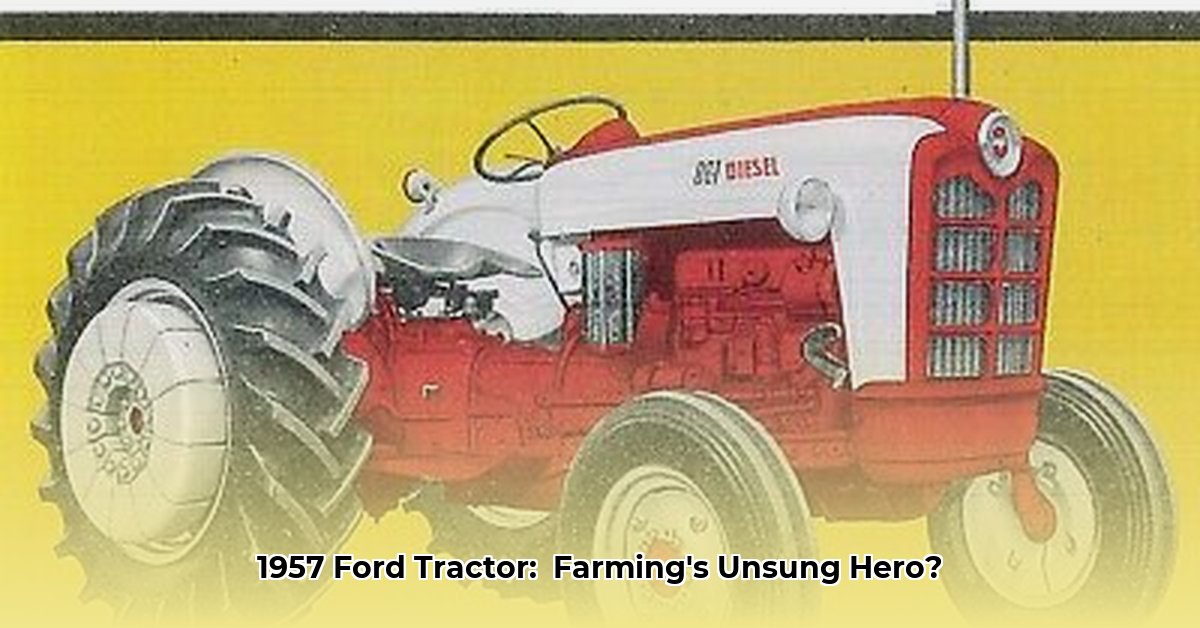
1957 Ford Tractor: A Legacy Forged in the Fields
The rhythmic chug of a powerful engine, the rich aroma of freshly turned earth, the sight of a robust machine effortlessly tilling a field – these evoke the golden age of farming. At the heart of this era often stood a Ford tractor, and the 1957 model holds a prominent position, representing a pivotal advancement in agricultural technology. This article explores its impact on farming practices, its relationship to sustainable agriculture, and its enduring legacy. We'll delve into the technical specifications, comparing it to predecessors and successors, and examining the long-term environmental implications of its design. For more on early Ford models, check out this resource on Ford 8N tractors.
Ford's Farming Revolution: From Humble Beginnings to a Powerful Legacy
Ford's entry into agricultural machinery started long before 1957. The 1939 Model 9N tractor, a relatively simple yet remarkably reliable and affordable machine, revolutionized farming. Its success laid the groundwork for future generations of Ford tractors. The evolution from the 9N to the 1957 model wasn't merely about increased horsepower; it was about refining design, enhancing efficiency, and simplifying the farming process. Each iteration built upon its predecessors, addressing shortcomings and enhancing capabilities. This continuous improvement is a testament to Ford's commitment to innovation in agriculture.
The 1957 Ford Tractor: A Closer Look at a Farming Icon
The 1957 Ford tractor represented a significant leap forward. Engine technology improvements resulted in enhanced fuel economy – a critical factor for cost-conscious farmers. Improved hydraulic systems simplified attaching and operating farming implements, streamlining workflow. This wasn't just about raw power; it was about intelligent power application for optimal efficiency. While not without its limitations, the 1957 model showcased the cutting edge of agricultural technology at the time.
Comparing the 1957 Model to its Predecessors and its Impact
How did the 1957 model differ from its ancestors? Early Fordson tractors, while robust, lacked the refinement of the 1957 model's operation and capabilities. The 1957 provided a smoother, more versatile experience. This progression from basic functionality to enhanced performance illustrates Ford's ongoing drive for optimization.
Farming Practices and Sustainability: A Balancing Act
The 1957 Ford tractor profoundly altered farming practices. Farmers could cultivate larger fields more efficiently, leading to larger harvests and reduced labor costs. However, the environmental impact requires careful consideration. Although fuel efficiency improved, long-term sustainability concerns, such as fuel consumption and its impact on the atmosphere, weren't as prominent then as they are now. This highlights a key tension between increased productivity and environmental responsibility.
The Enduring Legacy of the 1957 Ford Tractor
The 1957 Ford tractor solidified Ford's dominance in agricultural machinery. Its design influenced countless subsequent tractor models, both from Ford and competitors. Its emphasis on efficiency and productivity continues to shape modern farming equipment design. The innovation and drive for better performance embodied by the 1957 model persist, forming a key component of ongoing conversations about sustainable farming.
Technical Glimpses: Specifications of a 1957 Ford Tractor (Illustrative)
Note: Specifications varied depending on model and configuration.
| Feature | Specification (Example) | Notes |
|---|---|---|
| Engine Type | Gasoline | Some models offered diesel options. |
| Horsepower | 35-40 | Varied based on model and configuration. |
| Transmission | Manual | Simple, robust, and reliable design. |
| PTO (Power Take-Off) | Available | For powering attached implements. |
| Fuel Capacity | Varies (approx. 10-15 gallons) | Depended on the specific model. |
| Weight | Approximately 3,000 - 4,000 lbs | This varies slightly depending on configuration. |
How Did Ford Tractor Emissions Impact Sustainable Agriculture Practices?
Key Takeaways:
- Increased efficiency through mass production and affordability.
- Reliance on internal combustion engines raised environmental concerns.
- Influence on subsequent tractor designs and impact on agricultural practices.
- Increased yields but also contributed to emissions, prompting discussions about sustainability.
"The 1957 Ford tractor’s legacy is a complex narrative. While significantly increasing agricultural productivity, its reliance on fossil fuels necessitates a nuanced view of its impact on sustainable agriculture," says Dr. Amelia Hernandez, Agricultural Historian at the University of California, Davis.
The widespread adoption of the Ford tractor, and subsequent models, represents a double-edged sword in the context of sustainable agriculture. While greatly increasing yields and reducing the labor needed for farming, the reliance on fossil fuels introduced new challenges, prompting ongoing dialogue about mitigating environmental impact. The quest for truly sustainable agriculture requires continuous innovation in fuel technology and farming methods. The 1957 Ford tractor’s story reminds us of the multifaceted nature of progress.